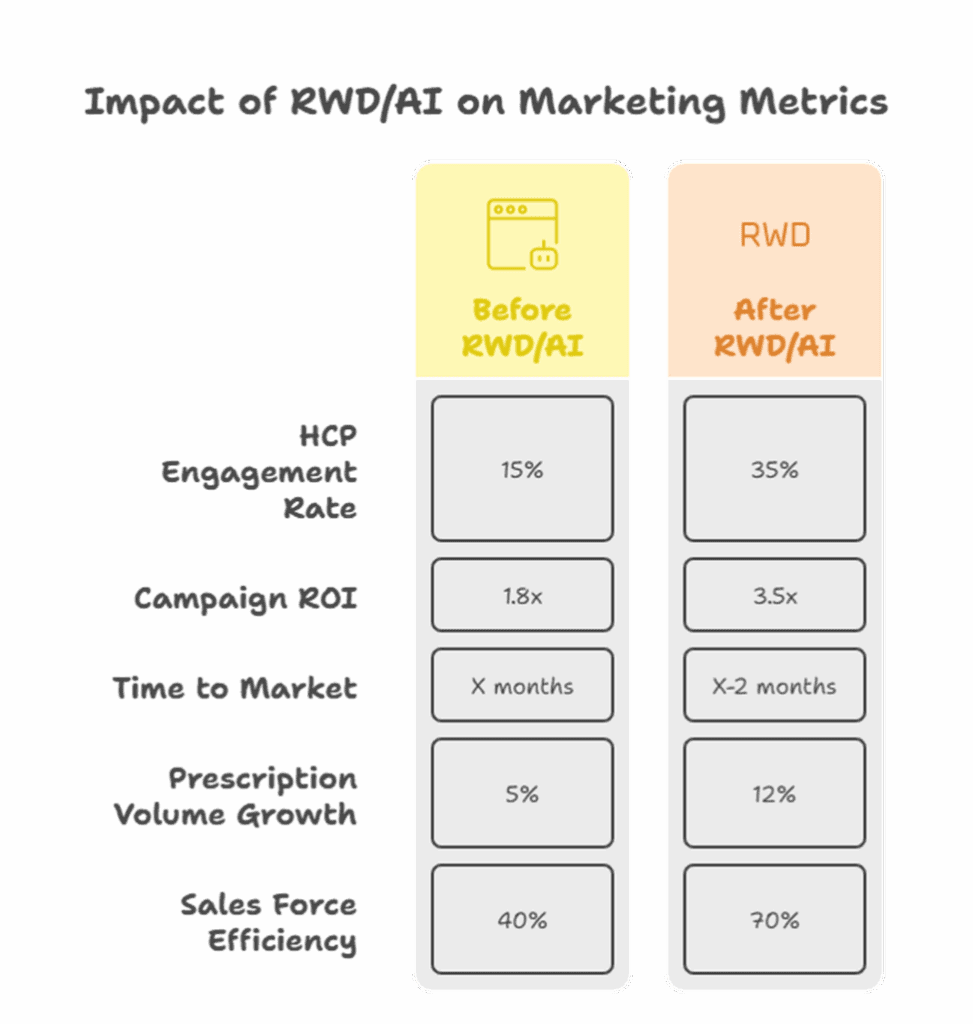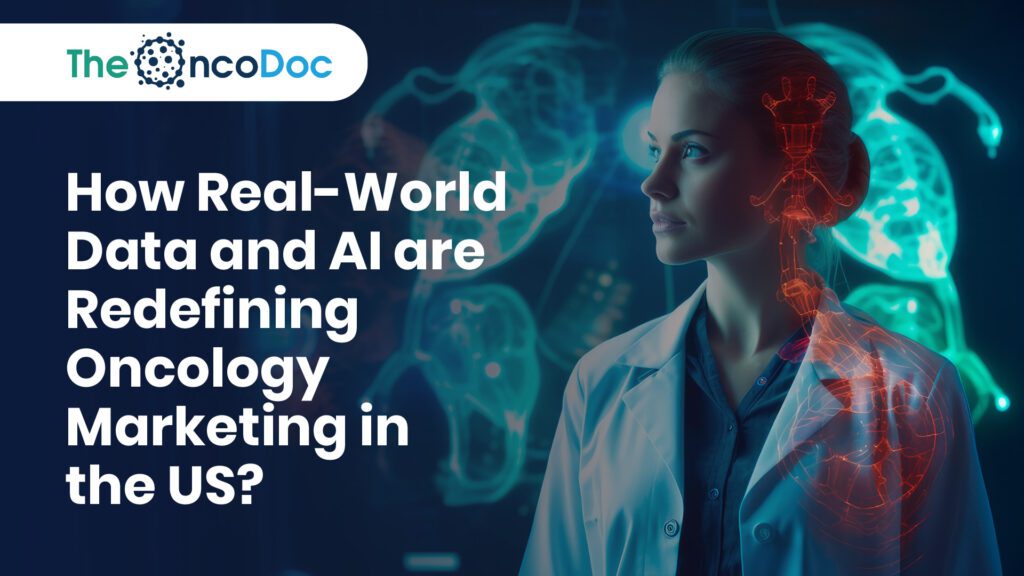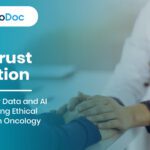Abstract
The oncology landscape in the United States is undergoing an unprecedented transformation, driven by scientific breakthroughs, evolving regulatory frameworks, and a rapidly digitizing healthcare ecosystem. For pharmaceutical companies, the traditional marketing playbook is no longer sufficient to navigate this complexity and effectively reach busy oncologists and engaged patient populations. This article delves into the revolution catalyzed by Real-World Data (RWD) and Artificial Intelligence (AI) in oncology marketing. We explore how RWD provides granular, actionable insights into treatment patterns, patient journeys, and unmet needs, while AI acts as the engine, enabling sophisticated analysis, predictive modeling, and hyper-personalized engagement strategies. Specifically, we will analyze the practical applications of RWD and AI in identifying high-value targets, optimizing channel mix, personalizing content, and measuring campaign effectiveness, all within the nuanced context of US pharmaceutical regulations and ethical considerations. The objective is to equip pharma managers with a comprehensive understanding of how to leverage these powerful tools to create smarter, more impactful, and ultimately, more patient-centric launches and ongoing marketing initiatives in oncology.
Introduction: The Shifting Sands of Oncology Marketing
The oncology market in the US is characterized by rapid innovation, high stakes, and a profoundly personal impact. The sheer volume of new therapies, coupled with increasing sub-specialization among oncologists and the growing influence of patient advocacy groups, presents both immense opportunities and significant challenges for pharmaceutical marketers. Historically, marketing strategies have relied heavily on broad-stroke campaigns, often based on aggregated market research and physician surveys. While these approaches have their place, they often lack the precision and agility required in today’s dynamic environment.
The digital revolution has permeated every facet of healthcare, from electronic health records (EHRs) to telehealth, and patient engagement platforms. This digital ubiquity generates an enormous volume of data – Real-World Data (RWD) – which includes electronic health records, claims data, pharmacy data, patient registries, genomic data, and even data from wearables. This rich tapestry of information, when properly harnessed, offers an unparalleled window into the actual practice of oncology, beyond the controlled environment of clinical trials.
Simultaneously, Artificial Intelligence (AI) has moved beyond theoretical discussions to practical applications across industries. In marketing, AI’s ability to process vast datasets, identify intricate patterns, predict future behaviors, and automate complex tasks is nothing short of revolutionary. When combined with RWD, AI transforms raw information into actionable intelligence, enabling a paradigm shift from mass marketing to precision engagement. For US pharma managers in oncology, understanding and implementing this RWD-AI synergy is no longer a competitive advantage, but a strategic imperative. This article will provide a roadmap for navigating this new era, focusing on practical applications and the measurable impact on marketing effectiveness.
The Power of Real-World Data (RWD) in Oncology
Real-World Data (RWD) encompasses data relating to patient health status and/or the delivery of healthcare routinely collected from a variety of sources. Unlike data from randomized controlled trials (RCTs), which are designed to demonstrate efficacy in controlled settings, RWD reflects the complexities and nuances of real-world clinical practice.

Sources of RWD Relevant to Oncology Marketing:
- Electronic Health Records (EHRs): These are foundational, providing insights into diagnoses, treatment regimens, lab results, physician notes, and patient demographics. For oncology, EHRs reveal the precise patient populations receiving specific therapies, the sequence of treatments, and outcomes in diverse patient subgroups.
- Claims Data: Data from insurance claims (e.g., Medicare, Medicaid, commercial payers) offer a longitudinal view of patient journeys, including physician visits, hospitalizations, procedures, and dispensed medications. They are invaluable for understanding access, adherence, and healthcare utilization patterns.
- Pharmacy Data: This data provides detailed information on prescription fulfillment, refills, and medication adherence, crucial for understanding the real-world uptake and persistence of oncology therapies.
- Patient Registries and Observational Studies: These can provide structured data on specific patient cohorts, often collecting information beyond what’s found in routine clinical care, such as patient-reported outcomes (PROs) or quality of life metrics.
- Genomic and Molecular Data: With the rise of precision oncology, genomic data from tumor profiling is increasingly integrated, providing insights into biomarkers that predict response to targeted therapies and immunotherapies. This data is critical for identifying specific patient segments.
- Social Media and Digital Footprint Data: While requiring careful ethical consideration, anonymized and aggregated digital data can provide insights into patient sentiment, disease awareness, and information-seeking behaviors.
How RWD Transforms Oncology Marketing:
- Precise Market Segmentation: RWD allows for the identification of highly specific patient segments based on not just demographics, but also clinical characteristics (e.g., specific mutations, prior lines of therapy, comorbidities), treatment sequences, and even geographic variations in care.
- Understanding the Patient Journey: By linking various RWD sources, marketers can map the complex journey of an oncology patient, from initial diagnosis through various treatment lines, recurrences, and palliative care. This reveals critical intervention points and unmet needs.
- Identifying “White Space” and Unmet Needs: RWD can highlight areas where current therapies are underperforming, where patient outcomes are suboptimal, or where specific patient populations are underserved. This intelligence is invaluable for product development and targeted messaging.
- Optimizing Product Launch Strategies: For new oncology therapies, RWD can inform launch sequencing, identify early adopters, and help predict uptake based on historical data for similar drugs.
- Evidence Generation for Value Proposition: Beyond clinical trial data, RWD can generate real-world evidence (RWE) to support the value proposition of a drug, demonstrating its effectiveness, safety, or economic benefits in routine clinical practice. This is increasingly important for payer discussions and formulary inclusion.
- Sales Force Effectiveness: RWD can guide sales representatives to the right oncologists, at the right time, with the right message, based on their prescribing patterns and patient profiles.

Example: Optimizing a Lung Cancer Drug Launch
Imagine launching a new targeted therapy for NSCLC with a specific genomic alteration. RWD from EHRs and claims data can identify:
- Oncologists who regularly test for this alteration.
- The volume of patients diagnosed with this specific mutation in their practice.
- Their current treatment protocols for these patients.
- Geographic clusters of high prevalence.
This granular information allows the marketing team to focus resources, tailor educational materials, and engage with the most relevant healthcare providers, far more effectively than a generic launch campaign.
The Artificial Intelligence Engine: Unleashing RWD’s Potential
While RWD provides the raw material, Artificial Intelligence (AI) provides the sophisticated tools to extract maximum value. AI encompasses a range of technologies, including machine learning (ML), natural language processing (NLP), and predictive analytics, each playing a crucial role in transforming RWD into actionable insights for oncology marketing.

Key AI Applications in Oncology Marketing:
- Predictive Analytics for Target Identification:
- “Next Best Action” Models: AI algorithms can analyze historical prescribing patterns, patient profiles from EHRs, and claims data to predict which oncologists are most likely to adopt a new therapy or switch from a competitor. This moves beyond simple segmentation to predictive targeting.
- Patient At-Risk Identification: For supportive care or complementary therapies, AI can identify patients at high risk of specific complications or adverse events, allowing for proactive educational campaigns for their treating physicians.
- Therapy Adherence Prediction: By analyzing pharmacy data and patient demographics, AI can predict which patients are at risk of non-adherence, enabling targeted interventions through HCPs.
- Early Indication of Market Shifts: AI can detect subtle changes in prescribing trends or diagnostic patterns from RWD, signaling emerging opportunities or competitive threats before they become widely apparent.
- Natural Language Processing (NLP) for Unstructured Data:
- Extracting Insights from Clinical Notes: A significant portion of RWD is locked within unstructured text in EHRs (physician notes, pathology reports). NLP can parse these notes to extract critical information like disease progression, treatment rationale, side effect profiles, and patient sentiment, which would be impossible to analyze manually at scale.
- Sentiment Analysis: Applying NLP to social media (with ethical and privacy safeguards) or patient forums can gauge real-world patient and caregiver sentiment towards specific diseases, treatments, or even pharmaceutical companies.
- Identifying Key Opinion Leaders (KOLs): NLP can analyze publications, conference abstracts, and clinical trial participation data to identify emerging KOLs and their specific areas of expertise, refining engagement strategies.
- Content Personalization and Omnichannel Orchestration:
- Dynamic Content Generation: AI can help personalize marketing materials (e.g., scientific summaries, patient education resources) based on an oncologist’s specialty, patient panel, and expressed interests, ensuring relevance.
- Channel Optimization: AI algorithms can determine the optimal channel mix (e.g., in-person visit, email, digital ad, medical education webinar) for each target oncologist, based on their past engagement behaviors and preferences.
- Automated Campaign Management: AI-powered platforms can automate the deployment of personalized content across multiple channels, track engagement in real-time, and dynamically adjust campaigns for optimal impact.
- “Next Best Message” Recommendation: Similar to “Next Best Action,” AI can suggest the most relevant message or piece of content to deliver to an oncologist based on their current clinical context and interaction history.
- Market Access and Payer Strategy:
- Evidence Synthesis: AI can rapidly synthesize vast amounts of RWD and published literature to build compelling real-world evidence for value-based contracting and formulary discussions.
- Payer Behavior Prediction: By analyzing historical claims data and payer policies, AI can predict the likelihood of formulary inclusion or restriction for new oncology therapies.
Example: Enhancing Engagement with Targeted Oncologists
A pharma company launching an immunotherapy for melanoma can use AI to:
- Identify oncologists with a high volume of melanoma patients, particularly those using specific diagnostic tests.
- Analyze their publication history and conference attendance (via NLP) to understand their research interests (e.g., specific biomarkers, combination therapies).
- Predict their preferred communication channels and content types.
- Automate the delivery of personalized scientific updates, patient case studies, or invitations to relevant educational events, ensuring a highly tailored and impactful interaction.
Ethical Considerations and Regulatory Landscape in the US
The use of RWD and AI in healthcare, particularly in oncology marketing, is subject to stringent ethical guidelines and regulatory frameworks in the US. Pharma managers must navigate these carefully.
Key Considerations:
- Patient Privacy (HIPAA): All RWD must be de-identified or aggregated to protect patient privacy in accordance with HIPAA regulations. Data anonymization techniques are paramount.
- Data Security: Robust cybersecurity measures are essential to protect sensitive healthcare data from breaches.
- Transparency and Trust: While direct patient interaction for marketing purposes is highly regulated, building trust with HCPs by being transparent about data sources and AI methodologies is crucial.
- Bias in AI Algorithms: AI models are only as good as the data they are trained on. If RWD contains inherent biases (e.g., underrepresentation of certain demographic groups), the AI outputs can perpetuate or even amplify these biases. Rigorous validation and fairness checks are necessary.
- FDA and FTC Regulations: Marketing claims derived from RWD and AI must comply with FDA regulations regarding truthfulness and substantiation, and FTC guidelines against deceptive practices. Off-label promotion remains strictly prohibited.
- Data Governance: Establishing clear policies and procedures for data acquisition, storage, processing, and use is critical. This includes defining roles, responsibilities, and audit trails.

Pharma companies must invest in robust data governance frameworks, legal expertise, and ethical review processes to ensure compliance and maintain public trust. Partnerships with specialized RWD and AI vendors often include assurances regarding data privacy and security.
Practical Implementation: A Roadmap for Pharma Managers
Implementing RWD and AI effectively requires a strategic, phased approach.
- Define Clear Business Objectives: Before diving into data, articulate what specific marketing challenges RWD and AI are intended to solve (e.g., increase market share, improve launch uptake, enhance sales force productivity, identify new patient populations).
- Assess Data Infrastructure and Access:
- Internal Data Audit: What RWD (e.g., CRM data, sales data, internal market research) is already available?
- External Data Partnerships: Identify and establish relationships with reputable RWD providers (e.g., IQVIA, Symphony Health, Flatiron Health, OptumInsight) and data aggregators. Evaluate their data quality, breadth, and compliance.
- Integration Strategy: How will disparate data sources be integrated and harmonized into a single, accessible platform?
- Invest in AI Capabilities:
- Build vs. Buy: Decide whether to develop in-house AI expertise or partner with specialized AI vendors and platforms that offer solutions tailored for healthcare marketing. Given the complexity, many opt for a hybrid approach or vendor partnership.
- Talent Acquisition: Recruit data scientists, AI engineers, and bioinformaticians with expertise in healthcare data.
- Training and Upskilling: Train existing marketing and sales teams on how to interpret and utilize AI-driven insights.
- Pilot Programs and Iteration:
- Start with small, well-defined pilot projects to demonstrate value and refine processes. For example, test AI-driven personalization on a specific segment of oncologists for a particular drug.
- Continuously monitor results, gather feedback, and iterate on AI models and marketing strategies.
- Change Management:
- Emphasize the “why”: Clearly communicate the benefits of RWD and AI to all stakeholders, from leadership to field teams.
- Address concerns: Proactively address fears about job displacement or data privacy. Position AI as an enabler, not a replacement.
- Foster a data-driven culture: Encourage experimentation, learning from failures, and celebrating successes driven by insights.
- Measure ROI:
- Establish clear KPIs (Key Performance Indicators) for each initiative (e.g., increased prescription volume, higher engagement rates, improved sales force efficiency, reduced cost per acquisition).
- Attribute success: Use advanced analytics to attribute marketing outcomes directly to RWD and AI-powered interventions.

Conclusion: The Future is Now – Are You Ready?
The convergence of Real-World Data and Artificial Intelligence represents the most significant transformation in oncology marketing in decades. For US pharma managers, this isn’t a futuristic concept but a present-day reality that demands immediate strategic attention. The ability to move beyond generic campaigns to hyper-personalized, data-driven engagement is not just about efficiency; it’s about efficacy. It’s about ensuring that the right message about life-changing therapies reaches the right oncologist, at the right time, ultimately benefiting the patient.
While challenges remain, particularly around data privacy, integration, and algorithmic bias, the potential rewards are immense. Pharma companies that embrace this RWD-AI playbook will gain a significant competitive edge, optimize their resource allocation, and foster stronger, more meaningful relationships with the oncology community. The future of oncology marketing is precise, predictive, and personalized. The question for every pharma manager is: Are you ready to lead this revolution, or will you be left behind? The time to act is now, to ensure that every launch is smarter, every interaction is more impactful, and every patient has the best possible chance at optimal care.
The Oncodoc team is a group of passionate healthcare and marketing professionals dedicated to delivering accurate, engaging, and impactful content. With expertise across medical research, digital strategy, and clinical communication, the team focuses on empowering healthcare professionals and patients alike. Through evidence-based insights and innovative storytelling, Hidoc aims to bridge the gap between medicine and digital engagement, promoting wellness and informed decision-making.



